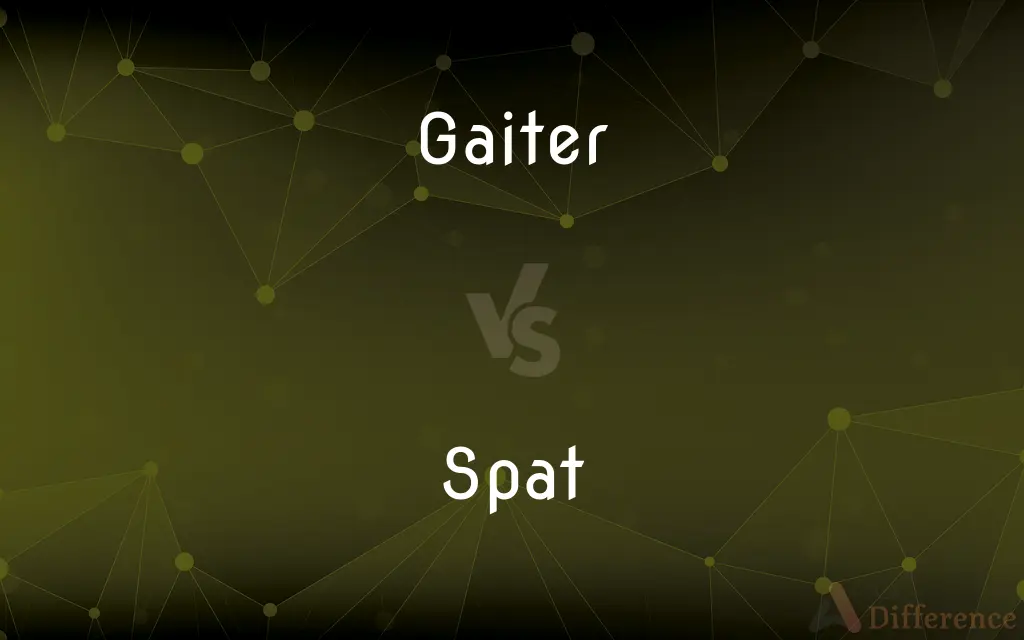Gaiter vs. Spat — What's the Difference?
Edited by Tayyaba Rehman — By Urooj Arif — Updated on April 16, 2024
A gaiter is a protective covering worn over the lower pants and shoe, primarily for outdoor activities, shielding against elements; spats are a formal accessory covering the ankle, used historically for style and slight protection.

Difference Between Gaiter and Spat
Table of Contents
ADVERTISEMENT
Key Differences
Gaiters are designed to protect the lower part of the legs and footwear from dirt, water, and snow, often used in hiking and hunting. In contrast, spats are primarily a fashion accessory from the early 20th century, worn over the shoes up to the ankle, to protect against dust and add a stylish element to men's dress.
While gaiters are made from durable, often waterproof materials like nylon or neoprene to withstand rough outdoor conditions, spats are typically crafted from lighter fabrics such as white canvas or leather, reflecting their use in cleaner, more formal settings.
Gaiters secure tightly around the leg and over the footwear with a combination of zippers, hooks, or Velcro, ensuring a snug fit that keeps out debris. On the other hand, spats cover only the ankles and are secured with buttons or elastic under the foot, making them less protective but more decorative.
In modern times, gaiters are commonly seen among outdoor enthusiasts, providing essential protection in environments where wearers might encounter brush, rocks, or snow. Conversely, spats are now mostly seen in historical reenactments or as part of costume designs, having largely fallen out of everyday use.
The functional focus of gaiters contrasts sharply with the aesthetic orientation of spats, underlining the practical versus stylistic intentions behind each item's design and use.
ADVERTISEMENT
Comparison Chart
Purpose
Protection from outdoor elements
Fashion and minimal protection
Material
Durable, often waterproof (nylon, neoprene)
Lighter, decorative (canvas, leather)
Coverage
Covers lower pants and footwear
Covers only the ankle and edge of the shoe
Fastening
Zippers, hooks, Velcro
Buttons, elastic bands
Use-case
Outdoor activities (hiking, hunting)
Formal wear, historical costumes
Compare with Definitions
Gaiter
Often made from materials like neoprene or Gore-Tex to ensure waterproofing and durability.
His neoprene gaiters were perfect for the muddy terrain.
Spat
Traditionally made from white canvas or leather for a decorative effect.
His leather spats were a hit at the historical fashion show.
Gaiter
A garment covering the lower leg and shoe, used for protection against the elements.
He wore gaiters to prevent snow from entering his boots while snowshoeing.
Spat
A short cloth covering for the ankle and lower part of the shoe, used historically in formal attire.
He completed his vintage outfit with a pair of white spats.
Gaiter
Protective wear used primarily in outdoor settings like hiking and hunting.
Her gaiters kept the mud off her pants during the wet trail hike.
Spat
Now often seen in theatrical costumes and historical reenactments.
The actor's spats were authentic to the period drama.
Gaiter
A piece of outdoor gear that helps keep debris and water out of footwear.
Gaiters are essential for crossing streams without getting soaked.
Spat
An accessory worn over shoes, fastened under the foot with an elastic strap.
The spats added an elegant touch to his 1920s gangster costume.
Gaiter
A durable accessory designed to provide additional leg protection.
Gaiters also protect against snake bites in bushy areas.
Spat
Used in the early 20th century primarily by men to protect shoes from mud and splashes.
Spats were once common in cities to protect from street dirt.
Gaiter
A heavy cloth or leather covering for the leg extending from the instep to the ankle or knee.
Spat
A past tense and a past participle of spit1.
Gaiter
A similar covering of moisture-resistant fabric, used by skiers and hikers.
Spat
To engage in a brief quarrel.
Gaiter
An ankle-high shoe with elastic sides.
Spat
To strike with a light spattering sound; slap.
Gaiter
An overshoe with a cloth top.
Spat
To slap.
Gaiter
A tubular collar fitting closely around the neck, often worn by skiers.
Spat
A larva of an oyster or similar bivalve that has settled by attaching to a surface.
Gaiter
A covering of cloth or leather for the ankle and instep.
Spat
A cloth or leather gaiter covering the shoe upper and the ankle and fastening under the shoe with a strap
The waiter wore spats as part of his uniform.
Gaiter
A covering cloth or leather for the whole leg from the knee to the instep, fitting down upon the shoe.
Spat
A brief quarrel.
Gaiter
Part of the ecclesiastical garb of a bishop.
Spat
(Informal) A slap or smack.
Gaiter
The dogwood, or a similar shrub.
Spat
A spattering sound, as of raindrops.
Gaiter
To dress with gaiters.
Spat
Simple past tense and past participle of spit
There was no sink in the room so we spat out the window.
If I had known you had a spittoon in the corner I would never have spat on the floor.
Gaiter
A covering of cloth or leather for the ankle and instep, or for the whole leg from the knee to the instep, fitting down upon the shoe.
Spat
(ambitransitive) To spawn. Used of shellfish as above.
Gaiter
A kind of shoe, consisting of cloth, and covering the ankle.
Spat
To quarrel or argue briefly.
Gaiter
To dress with gaiters.
Spat
To strike with a spattering sound.
Gaiter
A cloth covering (a legging) that provides covering for the instep and ankles
Spat
To slap, as with the open hand; to clap together, as the hands.
Gaiter
A shoe covering the ankle with elastic gores in the sides
Spat
The spawn of shellfish, especially oysters and similar molluscs.
Gaiter
Legging consisting of a cloth or leather covering for the leg from the knee to the ankle
Spat
A juvenile shellfish which has attached to a hard surface.
Spat
A covering or decorative covering worn over a shoe.
Spat
A piece of bodywork that covers the upper portions of the rear tyres of a car.
Spat
(aviation) A drag-reducing aerodynamic fairing covering the upper portions of the tyres of an aeroplane equipped with non-retractable landing gear.
Spat
A brief argument, falling out, quarrel.
Get into a trivial spat over punctuality
Have a vicious spat with the cousins
Spat
A light blow with something flat.
Spat
An obsolete unit of distance in astronomy (symbol S), equal to one billion kilometres.
Spat
A young oyster or other bivalve mollusk, both before and after it first becomes adherent, or such young, collectively.
Spat
A light blow with something flat.
Spat
Hence, a petty combat, esp. a verbal one; a little quarrel, dispute, or dissension.
Spat
A legging; a gaiter.
Spat
A kind of short cloth or leather gaiter worn over the upper part of the shoe and fastened beneath the instep; - chiefly in pl.
Spat
To emit spawn; to emit, as spawn.
Spat
To dispute.
Spat
To slap, as with the open hand; to clap together; as the hands.
Little Isabel leaped up and down, spatting her hands.
Spat
A quarrel about petty points
Spat
A cloth covering (a legging) that provides covering for the instep and ankles
Spat
A young oyster or other bivalve
Spat
Come down like raindrops;
Bullets were spatting down on us
Spat
Become permanently attached;
Mollusks or oysters spat
Spat
Strike with a sound like that of falling rain;
Bullets were spatting the leaves
Spat
Clap one's hands or shout after performances to indicate approval
Spat
Engage in a brief and petty quarrel
Spat
Spawn;
Oysters spat
Spat
Clap one's hands together;
The children were clapping to the music
Common Curiosities
Where were spats traditionally used?
Spats were traditionally used in formal settings, often as part of men's fashion in the early 20th century.
What materials are gaiters made from?
Gaiters are usually made from durable materials like nylon, neoprene, or Gore-Tex, which are often waterproof and designed to endure rough conditions.
Can gaiters be used in all seasons?
Yes, gaiters can be used in all seasons, with specific types designed for different weather conditions, such as lighter ones for summer and insulated ones for winter.
Are gaiters and spats interchangeable in their use?
No, gaiters and spats serve different purposes and are not interchangeable; gaiters are for practical outdoor protection, while spats are mainly for decorative purposes.
How do gaiters fit over footwear?
Gaiters fit snugly over the lower pants and shoes, secured with zippers, hooks, or Velcro to prevent debris from entering.
Why have spats fallen out of common use?
Spats have fallen out of common use due to changes in fashion trends and the practicality of modern footwear that offers more protection and comfort.
What are the key differences in the materials used for gaiters and spats?
The key differences lie in their durability and purpose; gaiters use more rugged, weather-resistant materials, while spats use lighter, more decorative materials.
What is the primary function of gaiters?
Gaiters are primarily used to protect the lower legs and shoes from outdoor elements like mud, water, and snow.
Are there different types of gaiters for various activities?
Yes, there are different types of gaiters designed for various activities, including lightweight ones for running and heavy-duty ones for mountaineering.
Do spats provide any practical benefits today?
Today, spats mostly provide aesthetic benefits as part of costumes or historical dress rather than practical benefits.
What occasions are spats appropriate for today?
Today, spats are appropriate for theatrical performances, historical reenactments, or fashion shows focusing on historical attire.
Can women wear spats and gaiters?
Yes, both gaiters and spats can be worn by women, especially gaiters which are used widely in mixed-gender outdoor activities.
How have gaiters evolved over time?
Gaiters have evolved from simple cloth wrappings to complex, engineered garments made with modern materials designed for specific environmental conditions.
How do spats enhance an outfit?
Spats add a touch of elegance and historical flair to an outfit, often enhancing formal attire with a distinctive, old-fashioned look.
What is the significance of buttons on spats?
The buttons on spats not only secure them in place but also add to their decorative appeal, aligning with their historical and formal use.
Share Your Discovery

Previous Comparison
Guinea vs. Pound
Next Comparison
Perspex vs. PolycarbonateAuthor Spotlight
Written by
Urooj ArifUrooj is a skilled content writer at Ask Difference, known for her exceptional ability to simplify complex topics into engaging and informative content. With a passion for research and a flair for clear, concise writing, she consistently delivers articles that resonate with our diverse audience.
Edited by
Tayyaba RehmanTayyaba Rehman is a distinguished writer, currently serving as a primary contributor to askdifference.com. As a researcher in semantics and etymology, Tayyaba's passion for the complexity of languages and their distinctions has found a perfect home on the platform. Tayyaba delves into the intricacies of language, distinguishing between commonly confused words and phrases, thereby providing clarity for readers worldwide.












































